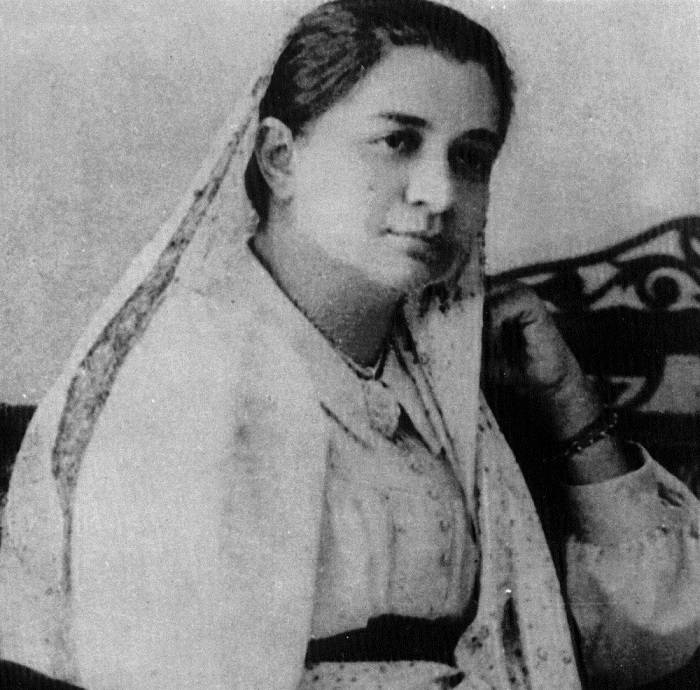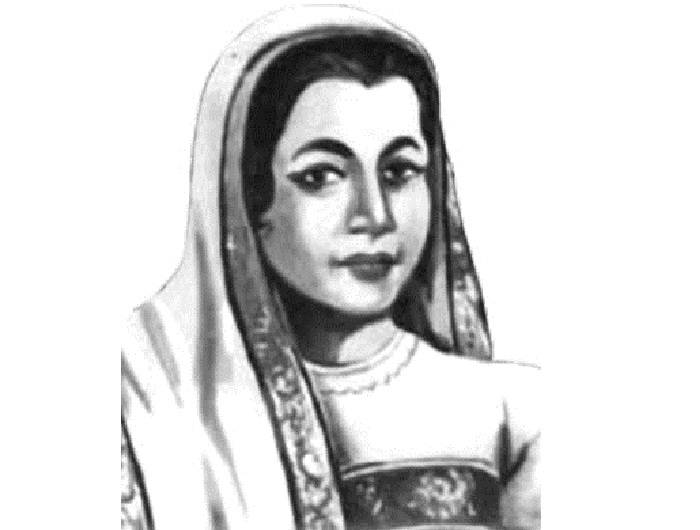Fast Facts
Date of Birth: September 24, 1861
Place of Birth: Bombay, British India
Death: August 13, 1936
Place of Death: Bombay, British India
Associated Organisations: India House, Paris Indian Society, Indian National Congress
Movement: Indian Independence Movement
Introduction
Bhikaiji Rustom Cama was a noted Indian independence activist. Coming from an affluent Parsi family, Bhikaiji was drawn towards the nationalist cause at an early age. Exiled in Europe for years, she worked with prominent Indian leaders. She co-founded ‘Paris Indian Society’ and established literary works like ‘Madan’s Talwar’ and emerged as the first person to unfurl the Indian flag abroad, calling it the “Flag of Indian Independence” while attending the second Socialist Congress at Stuttgart, Germany.

Image Credit : https://en.wikipedia.org/wiki/Bhikaiji_Cama
Childhood & Early Life
Madam Cama was born on September 24, 1861, in Bombay (now Mumbai) into the affluent Gujarati Parsi family of Sorabji Framji Patel and Jaijibai Sorabji Patel. Her father was a merchant and a prominent member of the Parsi community. Her parents were a well-known couple in the city. Just like several Parsi girls of her time, Bhikaiji too studied at the Alexandra Native Girls’ English Institution. As a child she was assiduous and disciplined and had an aptitude for languages. Growing up in an environment where the Indian nationalist movement was gradually gaining momentum, she got inspired by the cause that saw her arguing competently on the issue in different circles.
She married a rich pro-British lawyer Rustom Cama on August 3, 1885. Rustom was the son of Kharshedji Rustomji Cama (also referred as K. R. Cama) and wanted to get into politics. Bhikaiji’s association with socio-political issues was not taken well by her husband resulting in differences between the couple, which resulted into an unhappy marriage.

Image Credit : https://freedomcontributors.wordpress.com/2008/05/10/madam-bhikaji-cama/
Activism & Association with Freedom Movement
A famine struck Bombay in October 1896, followed by bubonic plague, which severely affected the life of the people. Bhikaiji played an active role in providing care for the afflicted and also helped in inoculation by getting involved with one of the groups working out of Bombay’s Grant Medical College. While working for the plague victims, Bhikaiji herself contracted the plague. Although she survived, the severely weak Bhikaiji was sent to Britain in 1902 for medical care.
On February 18, 1905, the noted Indian revolutionary Shyamji Krishna Varma founded ‘Indian Home Rule Society’ (IHRS) with the support of several prominent Indian nationalists in Great Britain, including social and political leader Dadabhai Naoroji, known as the Grand Old Man of India, and Singh Rewabhai Rana. Bhikaiji too supported the IHRS that aimed at promoting the cause of self-rule in British India. While staying in London, she was told that she will be allowed to return to India only if she signs a statement promising not to take part in nationalist movement. She refused to oblige, and sometime later in 1905, she shifted to Paris. The same year she co-founded the ‘Paris Indian Society,’ as a branch of IHRS, along with Munchershah Burjorji Godrej and S. R. Rana. She gave shelter to many world revolutionaries in her Paris home which was also visited by Lenin. In 1908, as Bhikaiji was planning to return to India, she was introduced to Varma. By that time Varma had become famous in the Indian community in London for delivering fiery nationalist speeches in the city’s Hyde Park. It was through Varma that Bhikaiji met Dadabhai Naoroji, who at that time was serving the British Committee of the Indian National Congress as its president. Bhikaiji started working as his private secretary.
She joined hands with notable nationalist members living in exile and penned down revolutionary literary works for the national movement and published them in Switzerland and the Netherlands before distributing them. One such literary work was the Indian nationalist publication from Paris, ‘Bande Mataram.’ Set up in response to the British ban on the nationalist poem ‘Vande Mataram,’ written by Bankim Chandra Chatterjee, the ‘Paris Indian Society’ started its operation in September 1909. Another notable publication set up by her in 1909 was the Indian Nationalist journal ‘Madan’s Talwar’ named after Indian revolutionary independence activist Madan Lal Dhingra, who had assassinated William Hutt Curzon Wyllie. The weekly was published from Berlin. Such publications were banned in India and England, and were smuggled to India through the French colony of Pondichéry.
Indian pro-independence activist Vinayak Damodar Savarkar was arrested with many other activists in 1909 after Wyllie’s assassination. While being transported by a ship back to India for trial the following year, he managed to flee while the ship docked in Marseilles harbour. As he reached late, he couldn’t find Bhikaiji and others who were expecting him, and fell into the custody of the British again. Such failure to save Savarkar was regretted by Bhikaiji for life. The French Government refused to co-operate with the British Government to extradite Bhikaiji. Following this her inheritance was seized by the British Government. Lenin reportedly gave her invitation to live in the Soviet Union, which she, however, refused.
She was also a staunch supporter of gender equality and believed that women will not only have right to vote but will also enjoy other rights after the independence of India.

Image Credit : https://www.storypick.com/the-story-of-bhikajicama/
First Person to Unfurl the Indian Flag Abroad
The Seventh Congress of the Second International, the International Socialist Congress, held in Stuttgart, Germany, in 1907, was attended by Bhikaiji on August 22. At the conference, she apprised the delegates about the damaging effects of famine on the Indian sub-continet. She appealed for equality, human rights and for independence of her motherland from the British Raj. The brave and resolute Bhikhaiji unfurled the Indian flag in front of hundreds of delegates from across the globe and termed it as the “Flag of Indian Independence.” She stunned all with her fiery speech saying “Behold, the flag of independent India is born! It has been made sacred by the blood of young Indians who sacrificed their lives in its honour. In the name of this flag, I appeal to lovers of freedom all over the world to support this struggle.” She appealed to the delegates at the conference to stand and salute the first flag of independent India. She had co-designed the flag along with Varma. Considered a modified version of the Calcutta Flag, it is counted among the templates considered in designing the present National Flag of India. Indian independence activist Indulal Yagnik later smuggled the same flag into British India, which is presently displayed at Pune’s ‘Maratha’ and ‘Kesari’ Library.
Exile
France became an ally of Britain at the very outset of the First World War in 1914. As a result of this, most of the members of the ‘Paris India Society’ left France, but Bhikaiji stayed back along with Singh Rewabhai Rana, although French lawyer and Socialist Jean Longuet had advised her to move to Spain with M.P. Tirumal Acharya. In October 1914, Bhikaiji and Rana were kept under arrest for a while as they attempted to incite the just arrived Punjab Regiment troops in Marseilles. As the two had to leave Marseilles, Bhikaiji went to Arcachon and joined Rana’s wife in the latter’s house. The French government sent her to Vichy in January 1915, and she was kept under confinement while Rana and his family were deported to the Caribbean island of Martinique. In November 1917, due to a deteriorating health, Bhikaiji was allowed to return to Bordeaux with the condition that she would report to the local police on a weekly basis. She returned to her Paris home at 25, Rue de Ponthieu, after the war ended. In 1935, she suffered a stroke that deteriorated her health further and left her paralysed. She made a petition to the British government via a prominent member of the Bombay Parsi community Sir Cowasji Jehangir that she be permitted to return to her motherland.

Image Credit : https://www.youtube.com/watch?v=UulAUQ6dLo8
Death
Bhikaiji returned to India in November 1935, along with Jehangir. On August 13, 1936, the fearless revolutionary who played an instrumental role in India’s struggle for freedom from as far as Europe, breathed her last at the Parsi General Hospital in Bombay, British India.
Legacy
She donated a major share of her personal assets for the Bai Avabai Framji Petit Parsi Girls Orphanage that set up a trust in her name, and also a substantial amount for Framji Nusserwanjee Patel Agiary, her family’s fire temple located at Mazgaon, in South Bombay.
To honour her work and contribution, many streets and places in India are named after her.
A commemorative stamp was issued in her honour by the Indian Posts and Telegraphs Department on the 11th Republic Day of India in 1962.
The Indian Coast guards commissioned ICGS Bikhaiji Cama, a Priyadarshini-class fast patrol vessel, in 1997 to commemorate her selfless service for the cause of independence.


